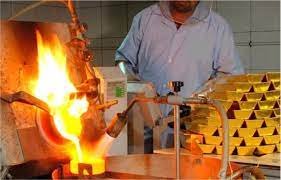Order Processor
SECTOR: GEMS & JEWELLERY
SUB-SECTOR: Handmade gold and gems-set jewellery
OCCUPATION: Marketing
REFERENCE ID: G&J/Q0201
ALIGNED TO: NCO-2004/ NIL
Order processor: Also known as ‘Order Taker’ or “Order Preparer’, the Order
Processor is among the first set of individuals working in the jewellery
manufacturing chain. Order Processor prepares the job sheet or order form
based on customer order.
Brief Job Description: The individual prepares a job sheet based on design
parameters of a jewellery order. The details on the job sheet serve as a
blueprint for the subsequent processes in the jewellery piece’s
manufacturing.
Personal Attributes: The job requires the individual to have: attention to
details and ability to work on computers for long hours. The individual must
also be able to use reflective skills in order to develop improved work
processes.
Unit Code G&J/N0201
Unit Title
(Task) Prepare order form or job sheet
Description This OS unit is about processing customer order in order to prepare a job sheet or
order form for use in subsequent work flow of manufacturing and delivering it
Scope This unit/task covers the following:
Receive customer’s order:
by e-mail
on telephone
by printed communication
from sales executive
as queries from exhibitions
from online shop
to match with existing design or model
and save a copy on computer
Prepare order form or job sheet to:
record customer’s details such as name, contact person and details
record jewellery design type ordered with details such as from catalogue or
design bank or fresh, design number or model number, product type, e.g.,
necklace, bangle
record detailing of jewellery ordered such as size, weight of gold and stones,
details such bangle as with clip or without clip
record type of frame and components required and their manufacturing
process, i.e., casting or handmade
record additional information such as Rhodium plating or enamelling or
embossing requirement
record amount of raw materials required and permitted gold loss
record delivery due date and number of jewellery pieces to be made
Call or contact customer to confirm:
order as per order form prepared
to make changes based on customer’s feedback
to send final order form to customer and superior for validation
Interact with other departments to:
check with stores department for raw materials available such as
components, precious metal, and gemstones/ diamonds
share new order form with Production Manager, Quality Check department
and seniors
Track order to:
follow-up with supervisors on delivery schedule
track the jewellery manufacturing status as per order form details
ensure timely delivery
Report problems related to:
computer failure
design mismatch between order received and that in design bank or catalogue
difficulty in matching assessment of precious metal and stones for ordered
jewellery piece as per customer’s requirement
order tracking and delivery schedule mismatch
To be competent, the user/individual on the job must be able to:
PC1. Make timely delivery of order form to Production department
PC2. accurately match customer’s sample with design bank or catalogue
PC3. accurately record detailing requirement of jewellery ordered
PC4. accurately assess time required for delivery
PC5. maintain order track for timely delivery of product
PC6. receive customer’s and senior’s consent on order form
Handling problems To be competent, the user/individual on the job must be able to:
PC7. check availability of materials and equipment
Knowledge and Understanding (K)
A. Organizational
Context
(Knowledge of the
company /
organization and
its processes)
The individual on the job needs to know and understand:
KA1. company’s policies on: Acceptable limits of gold loss per product type;
incentives; delivery standards; safety and hazards; integrity; and personnel
management
KA2. work flow involved in company’s jewellery manufacturing process and time
required to complete each stage
KA3. importance of the individual’s role in the workflow
KA4. reporting structure
B. Technical
Knowledge
The user/individual on the job needs to know and understand:
KB1. the different types of jewellery available with the company
KB2. terminologies used in jewellery manufacturing, both local and global
KB3. jewellery trends and types of precious metals and gemstones
KB4. different types of jewellery and their making technique, e.g., casting or
handmade
KB5. different types of components used in jewellery making
Skills (S) [Optional]
A. Core Skills/
Generic Skills
Basic reading and typing skills
The user/individual on the job needs to know and understand how:
SA1. to read design requirements of customer
SA2. to write job sheet or order form
SA3. to communicate with customer
The user/individual on the job needs to know and understand how:
SA4. to assess the material requirement for making the jewellery ordered
Communication skills
The user/individual on the job needs to know and understand how:
SA5. to communicate effectively with customer, seniors and colleagues
B. Professional Skills Computer skills
The user/individual on the job needs to know and understand how:
SB1. to use software for generating job sheet
SB2. to use MS Office tools for writing and recording
SB3. to import photograph in data bank and match
Decision making
The user/individual on the job needs to know and understand how:
SB4. to inform customer about any mismatch of expectations
SB5. to assess raw materials required for making new jewellery
SB6. to assess value of the jewellery and maximum gold/ stone loss standards
Unit Code G&J/N9910
Unit Title
(Task) Respect IPR of company as well as competitors
Description This OS unit is about maintaining company’s IPR and avoiding infringement on
copyright of others
Scope This unit/task covers the following:
Protect company’s Intellectual Property Rights (IPR)
prevent leak of new designs to competitors by reporting on time
be aware of any of company’s product or design patents
report IPR violations observed in the market, to supervisor or company heads
Avoid infringement to copyright of other companies
read copyright clause of the material published on the internet and any other
printed material
consult supervisor or senior management when in doubt about using publicly
available information
report any infringement observed in the company
To be competent, the user/individual on the job must be able to:
PC1. spot plagiarism and report
PC2. understand rationale of patents and IPR
PC3. avoid being involved in IPR violations
Knowledge and Understanding (K)
A. Organizational
Context
The individual on the job needs to know and understand:
KA1. company’s policies on IPR, plagiarism and order leaks
KA2. company’s patented products
KA3. market trends and company’s unique product range
KA4. reporting structure
B. Technical
Knowledge
The individual on the job needs to know and understand:
KB1. basics of patents and IPR laws
KB2. how IPR protection is important for competitiveness of a company
Skills (S) [Optional]
A. Core Skills/
Generic Skills
Communication skills
The user/individual on the job needs to know and understand how:
SA1. to effectively communicate any observed IPR violations or design leaks
B. Professional Skills Decision making
The user/individual on the job needs to know and understand when and how:
SB1. to report sources of IPR violations
The user/individual on the job needs to know and understand how:
SB2. to learn from past mistakes and report IPR violations on time
Critical thinking
The user/individual on the job needs to know and understand how:
SB3. to spot signs of violations and alert authorities in time
Unit Code G&J/N9912
Unit Title
(Task) Coordinate with co-workers
Description This OS unit is about communicating with colleagues and seniors in order to maintain
smooth ad hazards free work flow
Scope This unit/task covers the following:
Interact with supervisor to:
receive work instructions and raw materials from reporting supervisor
communicate to reporting supervisor about process flow improvements, product
defects received from previous process, repairs and maintenance of tools and
machinery as required
communicate any potential hazards or expected process disruptions
handover completed work to supervisor
Interact with colleagues within and outside the department to:
work as a team with colleagues and share work as per their or own work load and
skills
work with colleagues of other departments such as frame making or component
making or polishing or setting or stores
communicate an discuss work flow related difficulties in order to find solutions
with mutual agreement
receive feedback from QC and rework in order to complete work on time
To be competent, the user/individual on the job must be able to:
PC1. understand the work output requirements
PC2. comply with company policy and rule
PC3. deliver quality work on time as required by reporting any anticipated reasons
for delays
Interactions with
colleagues and other
departments
To be competent, the user/individual on the job must be able to:
PC4. put team over individual goals
PC5. resolve conflicts and multi-task
Knowledge and Understanding (K)
A. Organizational
Context
(Knowledge of the
company /
organization and
its processes)
The individual on the job needs to know and understand:
KA1. company’s policies on personnel management
KA2. work flow involved in company’s jewellery manufacturing process
KA3. importance of the individual’s role in the workflow
KA4. reporting structure
The individual on the job needs to know and understand:
KB1. how to communicate effectively
KB2. how to build team coordination
Skills (S) [Optional]
A. Core Skills/
Generic Skills
Teamwork and some multitasking
The individual on the job needs to know and understand how:
SA1. to share work load as required
SA2. to deliver product to next work process on time
B. Professional Skills Decision making
The individual on the job needs to know and understand:
SB1. how to report potential areas of disruptions to work process
SB2. when to report to supervisor and when to deal with a colleague depending
on the type of concern
Reflective thinking
The individual on the job needs to know and understand:
SB5. how to improve work process
Critical thinking
The individual on the job needs to know and understand:
SB6. how to spot process disruptions and delays
Unit Code G&J/N9914
Unit Title
(Task) Work towards having a safe work environment
Description This OS unit is about being aware of and communicating potential hazards and
dangers of accidents on the job
Scope This unit/task covers the following:
Understand potential sources of accidents
to avoid accidents related to use of potentially dangerous chemicals, gas torches,
sharp tools and hazards from machines
Communicate to reporting supervisor about:
process flow improvements to reduce anticipated or repetitive hazards
mishandling of tools, machines or hazardous materials
electrical problems that could result in accident
To be competent, the user/individual on the job must be able to:
PC1. spot and report potential hazards on time
PC2. follow company policy and rules regarding hazardous materials
PC3. deliver quality work on time as required by reporting any anticipated reasons
for delays
Knowledge and Understanding (K)
A. Organizational
Context
(Knowledge of the
company /
organization and
its processes)
The individual on the job needs to know and understand:
KA1. company’s policies on handling: harmful chemicals and sharp tools, safety and
hazards of machines, fire safety and, disposal of harmful chemicals and
materials
KA2. work flow involved in company’s jewellery manufacturing process
KA3. importance of the individual’s role in the workflow
KA4. reporting structure
B. Technical
Knowledge
The individual on the job needs to know and understand:
KB1. how different chemicals react and what could be the danger from them
KB2. how to use machines and tools without causing bodily harm
KB3. fire safety education
KB4. disposal of hazardous chemicals, tools and materials by following prescribed
environmental norms or as per company policy
Skills (S) [Optional]
A. Core Skills/
Generic Skills
Communication skills
The individual on the job needs to know and understand how:
SA1. to effectively communicate the danger
The individual on the job needs to know and understand:
SB1. importance of reporting potential sources of danger
SB2. appropriate actions to be taken in the event of an accident
SB3. process for disposing of hazardous materials, safely and following
environmental guidelines
Reflective thinking
The individual on the job needs to know and understand how:
SB4. to learn from past mistakes regarding use of hazardous machines or
chemicals or gas torches
Critical thinking
The individual on the job needs to know and understand:
SB4. How to spot danger
SB5. procedures to follow in the event of a fire or other hazard
Keywords /Terms Description
Sector Sector is a conglomeration of different business operations having similar
business and interests. It may also be defined as a distinct subset of the
economy whose components share similar characteristics and interests.
Sub-sector Sub-sector is derived from a further breakdown based on the
characteristics and interests of its components.
Occupation Occupation is a set of job roles, which perform similar/ related set of
functions in an industry.
Function Function is an activity necessary for achieving the key purpose of the
sector, occupation, or an area of work, which can be carried out by a
person or a group of persons. Functions are identified through functional
analysis and form the basis of OS.
Sub-function Sub-functions are sub-activities essential to fulfil the achieving the
objectives of the function.
Job role Job role defines a unique set of functions that together form a unique
employment opportunity in an organisation.
Occupational Standards
(OS)
OS specify the standards of performance an individual must achieve
when carrying out a function in the workplace, together with the
knowledge and understanding they need to meet that standard
consistently. Occupational Standards are applicable both in the Indian
and global contexts.
Performance Criteria Performance criteria are statements that together specify the standard of
performance required when carrying out a task.
National Occupational
Standards (OS)
NOS are occupational standards which apply uniquely in the Indian
context.
Qualifications Pack (QP) QP comprises the set of OS, together with the educational, training and
other criteria required to perform a job role. A QP is assigned a unique
qualifications pack code.
Unit Code Unit code is a unique identifier for an Occupational Standard, which is
denoted by an ‘N’
Unit Title Unit title gives a clear overall statement about what the incumbent
should be able to do.
Description Description gives a short summary of the unit content. This would be
helpful to anyone searching on a database to verify that this is the
appropriate OS they are looking for.
Scope Scope is a set of statements specifying the range of variables that an
individual may have to deal with in carrying out the function which have
a critical impact on quality of performance required.
Knowledge and
Understanding
Knowledge and understanding are statements which together specify the
technical, generic, professional and organisational specific knowledge
that an individual needs in order to perform to the required standard.
Organisational Context Organisational context includes the way the organisation is structured
and how it operates, including the extent of operative knowledge
managers have of their relevant areas of responsibility.
Technical Knowledge Technical knowledge is the specific knowledge needed to accomplish
specific designated responsibilities.
Core Skills/ Generic
Skills
Core skills or generic skills are a group of skills that are the key to learning
and working in today’s world. These skills are typically needed in any
work environment in today’s world. These skills are typically needed in
any work environment. In the context of the OS, these include
communication related skills that are applicable to most job roles.
Keywords /Terms Description
IPR Intellectual Property Rights
NOS National Occupational Standard(s)
NVQF National Vocational Qualifications Framework
NSQF National Qualifications Framework
NVEQF National Vocational Education Qualifications Framework
QP Qualifications Pack









